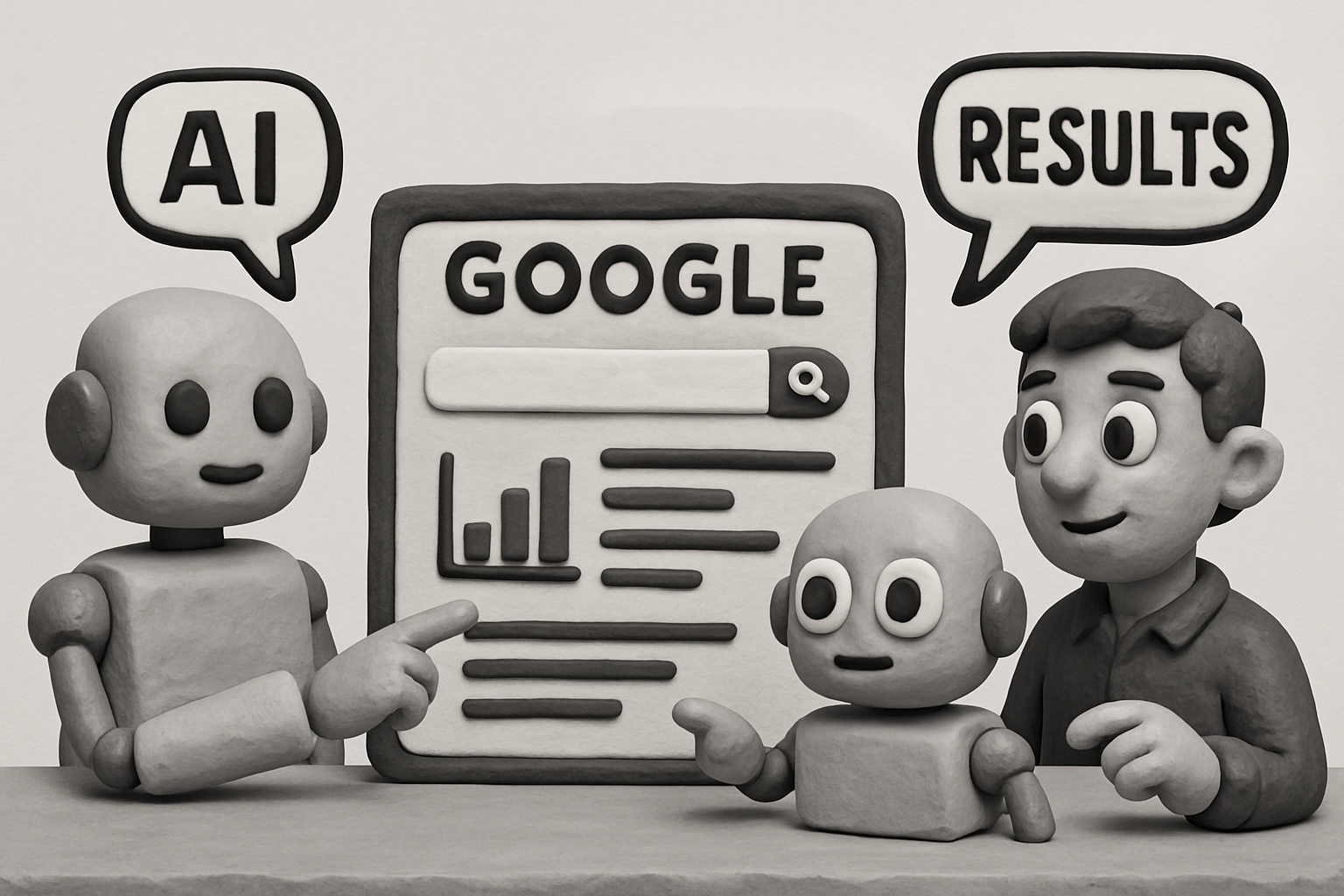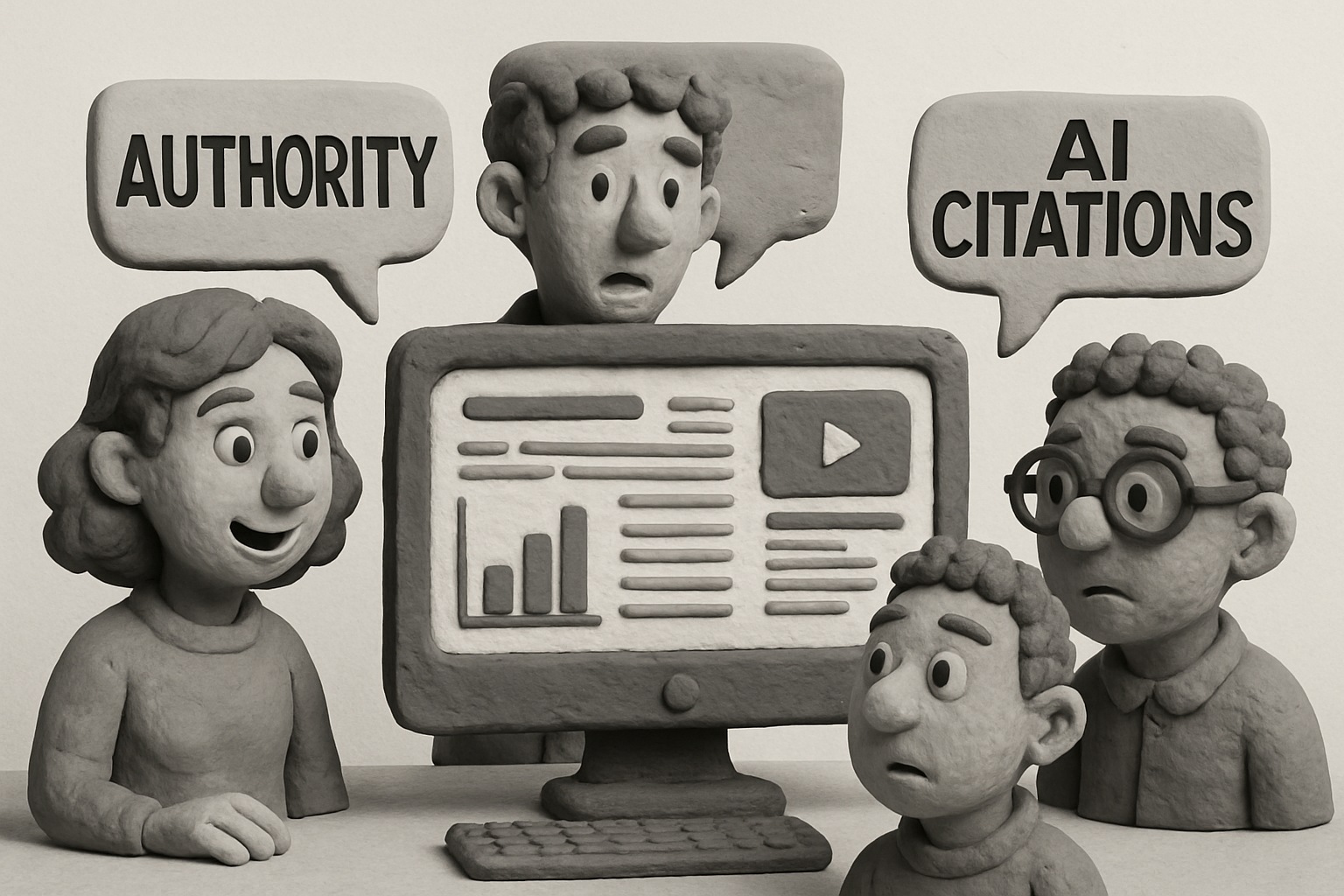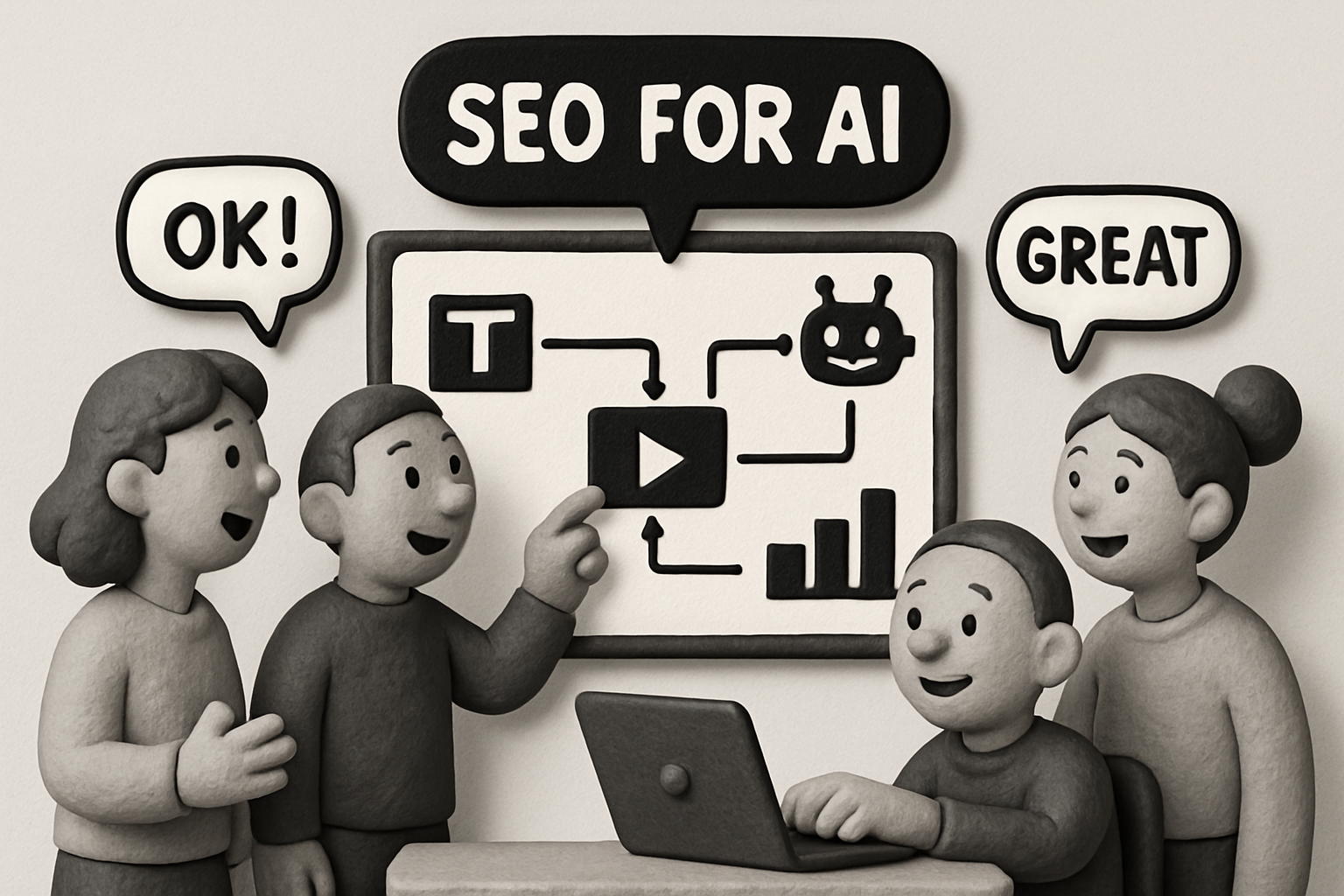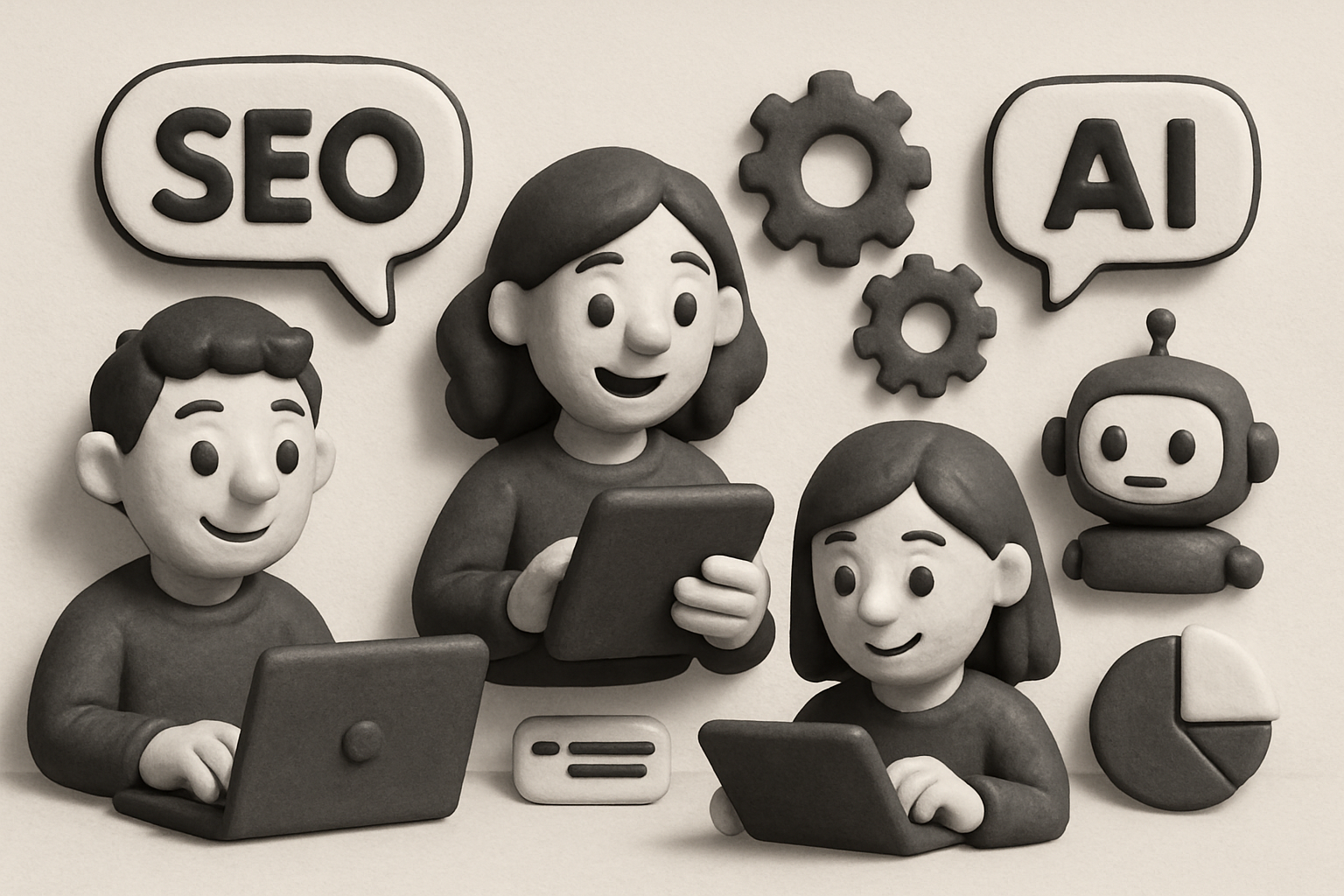AI-powered search platforms—like Google’s AI Overviews, ChatGPT, and Perplexity—are turning traditional SEO upside down. The old playbook no longer works. In 2025, succeeding with seo for ai means rethinking your approach, embracing new strategies, and keeping pace with fast-changing algorithms.
This guide is your roadmap for staying relevant. You’ll learn how these next-gen search engines operate, what ranking factors matter for large language models, and the exact steps to optimize your content for the AI era.
Ready to future-proof your visibility and outpace the competition? Let’s dive into the new rules of seo for ai and unlock the tactics you need to thrive.
Understanding AI-Driven Search in 2025
AI-driven search is rapidly transforming the digital landscape, and understanding this shift is essential for anyone focused on seo for ai. The rules of the search game are being rewritten—from how information is retrieved to how users interact with results. Let’s break down the core changes shaping 2025.

The Evolution of Search: From Keywords to Reasoning Engines
Traditional SEO focused on keywords, but seo for ai means optimizing for platforms that reason and synthesize. Google’s AI Mode, Perplexity, and ChatGPT Search now analyze intent, context, and user history. Instead of simple rankings, these engines deliver probabilistic, context-rich answers—often as summaries or “zero-click” results.
AI-driven search retrieves information at the passage level, assessing semantic similarity and user embeddings to present relevant, multimodal results. For example, Google AI Overviews blend text, video, and images for a richer experience. Recent data shows that tools like Perplexity now account for up to 10% of site traffic for early adopters, a trend that will only accelerate as seo for ai matures.
The New Role of Citations, Authority, and Content Types
AI platforms have changed how they cite sources, which impacts your seo for ai strategy. Perplexity boasts a 100% citation rate, while Gemini cites about 30% of the time, and ChatGPT includes citations on request. These platforms prefer listicles, comprehensive guides, and data-backed articles for citation.
YMYL (Your Money Your Life) queries heavily favor authoritative domains like universities or government sites. In contrast, general queries often pull from a wider range of sources, including blogs and SMBs. Perplexity, for instance, frequently cites videos and images for non-YMYL topics, expanding the types of content that can gain visibility through seo for ai.
Personalization, Memory, and the Agentic Web
Personalization is now at the heart of seo for ai. AI-powered search engines tailor results based on user history, preferences, and ongoing conversations. Features like Google’s DeepSearch and persistent ChatGPT threads mean the search journey is dynamic, with memory shaping each subsequent result.
The rise of the agentic web, where bots remix and reformat your content, means your brand’s visibility depends on how well your content can be adapted by AI agents. This shift requires a new approach to content strategy—one that anticipates ongoing, personalized interactions rather than static, one-time visits.
The Multimodal, Multilingual Future
AI-driven search has become inherently multimodal and multilingual—an essential factor for seo for ai. Engines blend text, audio, video, and interactive data visualizations in their results. Content in one language can be translated and cited in another, dramatically expanding your reach.
Google’s AI Overviews now incorporate custom charts and tools like Veo and Imagen, while Perplexity often embeds YouTube videos and images alongside articles. This multimodal approach means optimizing for visuals and multiple languages isn’t optional—it’s core to effective seo for ai.
The End of “Just SEO”: Why Old Tactics Don’t Work
Relying on traditional SEO tools and tactics is no longer enough for seo for ai. Methods like TF-IDF and BM25 can’t keep up with dense retrieval, semantic clustering, or passage-level indexing used by modern AI engines. In a zero-click world, getting cited matters more than ranking in the traditional sense.
Recent studies reveal that Google AI Overviews have reduced organic clicks by up to 34.5%. SEOs must pivot quickly—focusing on structured data, citation optimization, and semantic relevance—to remain visible. For practical steps on adapting your strategy, see Optimizing content for AI search.
Ranking Factors for AI Search Engines & LLMs
Navigating ranking factors in the era of seo for ai means rethinking everything you know about search algorithms. AI-powered engines and large language models (LLMs) now prioritize different signals than traditional search, demanding a new approach to content, authority, and optimization. Let’s break down what matters most for visibility in 2025.

Key Content Signals: Depth, Structure, and Recency
Modern seo for ai platforms crave deep, well-structured content. AI search engines favor articles in the 1,000–1,500 word range, packed with up-to-date information. Clear formatting—like headings, bullet points, and Q&A sections—helps LLMs extract relevant passages. Incorporate recent statistics, expert insights, and prominent dates to increase your chances of being cited.
Content that answers questions directly at the top, then expands with detailed explanations, performs best. “Ultimate Guide” and “How To” formats are especially prized. AI tools such as Perplexity and Gemini often select content that is both fresh and comprehensive, rewarding those who update regularly.
Authority, Trust, and Domain Reputation
For seo for ai, authority is everything—especially on YMYL (Your Money Your Life) topics. AI search engines weigh domain reputation heavily, preferring sources like universities, government sites, and top publishers for sensitive queries. For general questions, LLMs are more flexible, citing niche blogs and business sites with demonstrated topical expertise.
Boost your authority signals with strong backlinks, consistent internal linking, and by showcasing expert credentials. Different AI platforms (like Perplexity and Gemini) may weigh trust factors uniquely, but overall, building a trustworthy domain remains non-negotiable for ranking.
Multimodal Content: Images, Video, and Data Visualizations
To win at seo for ai, don’t stop at text. AI-driven search engines now embed YouTube videos, images, and custom charts directly in results. Perplexity, for example, includes images in 70% of general queries and videos in 76%. Google’s AI Overviews are pushing dynamic, interactive visuals to the forefront.
Prioritize original images, infographics, and embedded videos relevant to your topic. For YMYL content, media is cited less often, but for most queries, strong visuals can boost your citation rate and visibility. Use descriptive alt text and captions to help AI understand your media assets.
Passage-Level Relevance, Semantic Optimization, and FAQ
The core of seo for ai is optimizing not just pages, but passages. AI engines retrieve and cite specific sections that answer user queries. Focus on semantic keyword clusters and related entities—think intent, not just traditional keywords. Structure your content to answer multiple related questions, using FAQ and Q&A formats throughout.
Adding clear, direct answers within each section increases your likelihood of being cited for follow-up questions. Perplexity, for instance, generates additional questions and often cites well-optimized passages, not just entire articles. Internal linking can further reinforce your topical authority.
Citation Optimization and Zero-Click Visibility
In the world of seo for ai, being cited is often more valuable than a traditional click. AI platforms frequently deliver zero-click answers, pulling information straight from your content. To maximize citation rates, use structured data, schema markup, and clear, concise answers at the top of articles.
Anticipate related queries and address them within your content. Monitor which pages and passages are being cited, then refine your approach. For a deeper dive on aligning your strategy, check out AI and SEO integration strategies for actionable best practices.
Step-By-Step: How to Optimize Your SEO for AI in 2025
Adapting your seo for ai strategy is no longer optional—it's essential to thrive in the evolving search landscape. Follow this actionable, step-by-step process to future-proof your content and stay ahead of the curve. Each step will help you align with how AI search engines retrieve, rank, and cite information in 2025.

Step 1: Research AI-First Search Behavior and Query Types
Success with seo for ai starts by understanding how people interact with AI search engines. Users now phrase questions more conversationally, often using natural language and context-rich prompts.
Begin by analyzing AI-generated queries and follow-up questions. Study platforms like Perplexity and ChatGPT to see how they interpret intent and generate new queries. Use tools that simulate AI search to identify long-tail, question-based, and intent-driven keywords.
Consider leveraging AI-powered keyword research tips to discover what users are really asking. This approach uncovers patterns in conversational search that traditional keyword tools often miss.
Map out sample queries and topical clusters. For example, a 500-query study showed that conversational, multi-step queries now dominate seo for ai optimization. Focus your research on these evolving patterns to ensure your content is always a step ahead.
Step 2: Create Comprehensive, Structured, and Conversational Content
To win in seo for ai, your content must be both deep and easy for AI to parse. Write in-depth articles (1,000–3,000 words) that address topics holistically, covering every angle and related subtopic.
Use clear headings, bullet points, and lists to break up information. Start with a direct, concise answer to the main question—then expand with supporting data, expert opinions, and reputable citations. This structure not only helps users but also enables AI models to extract relevant passages.
Format your content for Q&A, anticipating follow-up or related queries. For example, an article on “How to consolidate credit card debt” that opens with a summary, then dives into step-by-step instructions and common questions, is more likely to be cited by AI search engines.
Remember, seo for ai rewards content that is both comprehensive and conversational. Make your writing approachable and easy to reference for both humans and machines.
Step 3: Incorporate Multimedia and Visuals Strategically
Modern seo for ai is multimodal—AI search engines increasingly favor content with images, videos, and infographics. Embedding original visuals relevant to your topic can significantly boost your chances of being cited.
Add YouTube videos (either your own or from authoritative sources) to your articles. Use original charts, diagrams, and infographics to break down complex ideas. Always include descriptive alt text and captions so AI can interpret your visuals accurately.
For example, articles with embedded YouTube videos are often cited by Perplexity, even if the written content is shorter. By integrating visuals, you diversify your content and make it more attractive for citation in AI-powered search results.
Keep in mind that seo for ai now means thinking beyond text—your visual assets are just as important for visibility.
Step 4: Optimize for Authority, Recency, and Trust
Building authority and trust is fundamental to seo for ai, especially for YMYL topics. Regularly update your articles with the latest data and expert insights to maintain freshness.
Pursue backlinks from reputable sources in your industry. Display clear author credentials and demonstrate your expertise with transparency—these signals are crucial for both users and AI algorithms. Implement structured data (schema.org) to make your authority and trust signals machine-readable.
For YMYL content, visible authority is non-negotiable. AI search platforms heavily favor domains with established credibility. Make sure your seo for ai strategy includes both on-page and off-page trust-building activities to maximize your chances of being cited.
Step 5: Semantic and Passage-Level Optimization
AI search engines now retrieve and cite content at the passage level. To optimize seo for ai, focus on making each section of your article independently valuable.
Cluster related keywords and entities semantically throughout your content. Structure your articles to answer multiple related queries in one place, using internal links to reinforce topical authority.
For example, AI models often cluster and cite specific passages, not entire pages. By optimizing individual sections for clarity and relevance, you increase your likelihood of being cited for more queries.
Use tables or Q&A blocks to organize information—this makes it easier for AI to extract and present your insights. Remember, effective seo for ai means thinking at both the page and passage level.
Step 6: Track, Analyze, and Iterate Based on AI Citations
Monitoring your performance is key to effective seo for ai. Track which articles and specific passages are cited by AI platforms like Perplexity, ChatGPT, and Gemini.
Use analytics tools to measure referral traffic from these sources separately from traditional organic. Adjust your content strategy based on what’s being cited most frequently and which queries drive the most engagement.
For example, some sites saw a 67% increase in Perplexity-driven traffic after targeted optimization. Continuously iterate your seo for ai approach by analyzing citation data and refining your content accordingly.
Step 7: Prepare for Emerging AI Search Platforms and Features
The seo for ai landscape is evolving rapidly, with new AI search engines and features launching regularly. Stay updated on platform-specific guidelines—experiment with features like Perplexity Pages or Google’s DeepSearch.
Test and adapt your content based on changes in AI citation patterns and ranking factors. For instance, anticipate further integration of AI modes and conversational features in Google and other engines.
Early adopters of new platforms often gain a significant visibility advantage. Make ongoing experimentation a core part of your seo for ai strategy to maintain an edge as the search ecosystem continues to transform.
Advanced Strategies: Technical SEO & Automation for AI Search
Adapting your seo for ai approach in 2025 means going beyond on-page basics. Technical SEO and automation now play a central role in ensuring your content is not just found, but also cited and remixed by advanced AI engines. Let’s break down the essential strategies for future-proofing your site.

Technical Optimization for AI Indexing and Retrieval
The foundation of seo for ai is technical excellence. AI search engines demand fast, mobile-optimized sites with clear, structured data. Ensure every page is crawlable—use robots.txt wisely and maintain up-to-date XML sitemaps.
Implement passage-level markup so AI can extract relevant snippets. Structured data (like FAQPage, HowTo, and schema.org types) helps engines parse content contextually.
Support multimodal content by adding descriptive alt text, video transcripts, and rich metadata. Use canonical tags for duplicate content and keep your site architecture logical for both humans and bots. These steps ensure your content is ready for AI-driven retrieval and citation.
Leveraging Automation and AI Tools for Scalable SEO
Scaling seo for ai requires automation. Modern AI-powered tools handle keyword research, topic clustering, content generation, and even internal linking at scale. Automation frees up your team to focus on high-level strategy, not just manual tasks.
Platforms now offer daily content publishing, real-time SEO scoring, and multimedia embedding. For a deeper dive into the best solutions for automating these workflows, check out this Best AI SEO tools overview.
Automated analytics can also identify which passages or visuals get cited most, letting you iterate quickly. Adopting these tools is essential to stay ahead as AI search platforms evolve.
Multilingual and Multimodal SEO Tactics
AI-driven search engines are natively multilingual and multimodal—so your seo for ai strategy must be too. Create content in multiple languages to expand your reach and citation potential. Use reputable translation and localization tools to maintain quality and context.
Don’t stop at text. Embed original images, charts, and videos. Provide transcripts for audio and captions for video, which AI bots use to better understand and cite your content.
Optimizing for multimodal search means your articles can be cited in any language, in any content format, across global AI platforms. This expands your visibility far beyond traditional SERPs.
Monitoring, Measurement, and AI-Specific Analytics
Measuring the impact of seo for ai goes beyond standard organic metrics. Start by tracking referral traffic from AI platforms like Perplexity, ChatGPT, and Gemini separately. Use analytics tools to identify which articles and passages are being cited, not just clicked.
Review engagement and conversion rates from AI-driven traffic—these often outperform traditional organic channels. If possible, set up dashboards that monitor citation frequency and query types.
Regularly analyze this data to fine-tune your content and technical setup. This feedback loop is vital for ongoing optimization as AI search behaviors evolve rapidly.
Future-Proofing Your SEO Stack for AI Evolution
To keep your seo for ai strategy resilient, invest in flexible tools and processes. Choose platforms that adapt to new AI features, ranking factors, and algorithm updates. Regularly update your content, technical stack, and analytics workflows.
Build a modular site infrastructure that can scale with new formats—think dynamic visuals, interactive content, and emerging data types. Encourage your team to experiment, iterate, and learn as the AI landscape shifts.
Early adopters who prioritize adaptability and innovation will lead the way in the AI-first search era, capturing new audiences and staying ahead of competitors.
Content Formats, Case Studies, and Real-World Examples
In the rapidly shifting world of seo for ai, understanding which content formats, tactics, and real-world examples drive results is crucial. Let’s break down the winning strategies for visibility and AI-driven traffic.
Winning Content Types for AI Citations
Certain formats consistently outperform others for seo for ai. AI platforms like Perplexity and Gemini favor content that’s easy to parse, comprehensive, and answers clear user intent.
- Listicles: Structured lists are highly cited (91% for YMYL, 35% for general queries).
- How-to guides and ultimate guides: Step-by-step, actionable, and thorough.
- FAQ-rich articles: Anticipate follow-up questions and conversational queries.
- Date-stamped, data-backed posts: Recency and authority are key.
A recent C-SEO Bench: Evaluating Conversational SEO benchmark shows that conversational, structured formats dominate AI citations—especially when titles include “best,” “guide,” or clear dates.
Case Study: AI-Driven Traffic Growth
Let’s look at a real-world example of seo for ai in action. After an in-depth optimization using AI-focused strategies, one site saw Perplexity-driven traffic surge by 67% in just months. Newsletter signups doubled, and engagement rates were noticeably higher.
Key tactics included:
- Embedding multimedia (charts, videos)
- Regular content updates with new data
- Structured Q&A sections
Empirical studies like White Hat SEO using Large Language Models further reinforce that generative AI-optimized content drives measurable gains in both citation frequency and user interaction.
Examples of Multimodal Content in AI Search
Multimodal content is now essential for seo for ai. AI search engines blend text, images, video, and even data visualizations within results.
- Embedded YouTube videos: 47% of Perplexity results feature at least one video.
- Custom images and infographics: 70% of general queries display visuals.
- Short, video-rich articles: Sometimes outperform longer text-only pages.
- Google AI Overviews: Integrate custom charts and dynamic visuals directly in SERPs.
The takeaway? Content creators must think beyond text—embrace visuals and multimedia, formatted for easy AI parsing.
Lessons from Authority and Niche Sites
Authority is still vital in seo for ai, but the playing field is shifting. For YMYL queries, only the most reputable domains—universities, governments, major publishers—are cited. But general queries allow for niche experts, blogs, and even affiliate content to shine.
- Niche blogs: Frequently cited for specialized, non-YMYL topics.
- Affiliate content: Still earns citations in Perplexity, less so in Google.
- Consistent optimization: Domains with well-structured, AI-ready content are cited across multiple queries.
As seo for ai evolves, both authority and agility matter—niche expertise is often rewarded in more diverse AI ecosystems.
The Future of SEO in an AI-First World
As we step into the AI-first era, search is transforming at breakneck speed. The way users interact with results—and the way platforms interpret and display information—has fundamentally changed. For anyone serious about seo for ai, understanding these seismic shifts is essential to stay visible and relevant.
The Shift to Zero-Click, Agentic, and Personalized Search
AI-powered search engines now prioritize direct answers, not just lists of links. Visibility is no longer about being ranked first—it's about being cited and remixed by AI agents. Every user's journey is unique, shaped by their history, questions, and context.
Bots (agents) are increasingly the main consumers and interpreters of your content. This means your seo for ai strategy must consider how AI aggregates, summarizes, and presents your expertise. The Agentic AI Optimization (AAIO) research paper explores new methods for optimizing not just for human readers, but for these autonomous AI agents that now shape the search landscape.
The Multimodal, Dynamic SERP
Today's AI-first SERPs blend text, images, charts, audio, and video—often in real time. Your content must be ready to appear in any format, at any moment.
Google's AI Overviews and similar tools remix information into dynamic displays, pulling in videos, data visualizations, and more. To maximize seo for ai, create adaptable content that can be easily cited, clipped, or transformed by AI. The ability to provide rich media, structured data, and clear passages increases your chances of being featured in these evolving SERPs.
Challenges and Opportunities for SEOs and Marketers
The arrival of AI-driven search brings both hurdles and exciting new prospects for those focusing on seo for ai. Traditional organic clicks are declining—as much as 34.5% in some cases—due to zero-click answers.
However, new metrics like citation frequency, AI-driven engagement, and conversion rates are emerging. Early adopters can:
- Capture untapped AI-driven audiences
- Build authority through frequent citations
- Leverage conversational and multimedia content
Staying agile and monitoring AI citation patterns is crucial to capitalize on these opportunities.
Essential Skills and Mindsets for 2025 and Beyond
Success with seo for ai in 2025 requires a blend of experimentation, continuous learning, and technical savvy. Embrace rapid iteration and invest in AI literacy—understanding how algorithms and agents process your content.
Building flexible teams and workflows is now non-negotiable. Those who optimize for both human readers and machines will own the future of search. Adopt a growth mindset, stay curious, and make adaptation part of your SEO DNA.
Now that you know how AI is reshaping SEO and what it takes to stay ahead in 2025, it’s time to put these strategies into action. Trying to juggle content creation, keyword research, and ever-changing algorithms on your own can be overwhelming—but you don’t have to go it alone. With RankPill, you can automate the heavy lifting and focus on what really matters: growing your business. If you’re ready to future-proof your SEO, save time, and boost your organic traffic effortlessly, let’s take the next step together.
Get Started